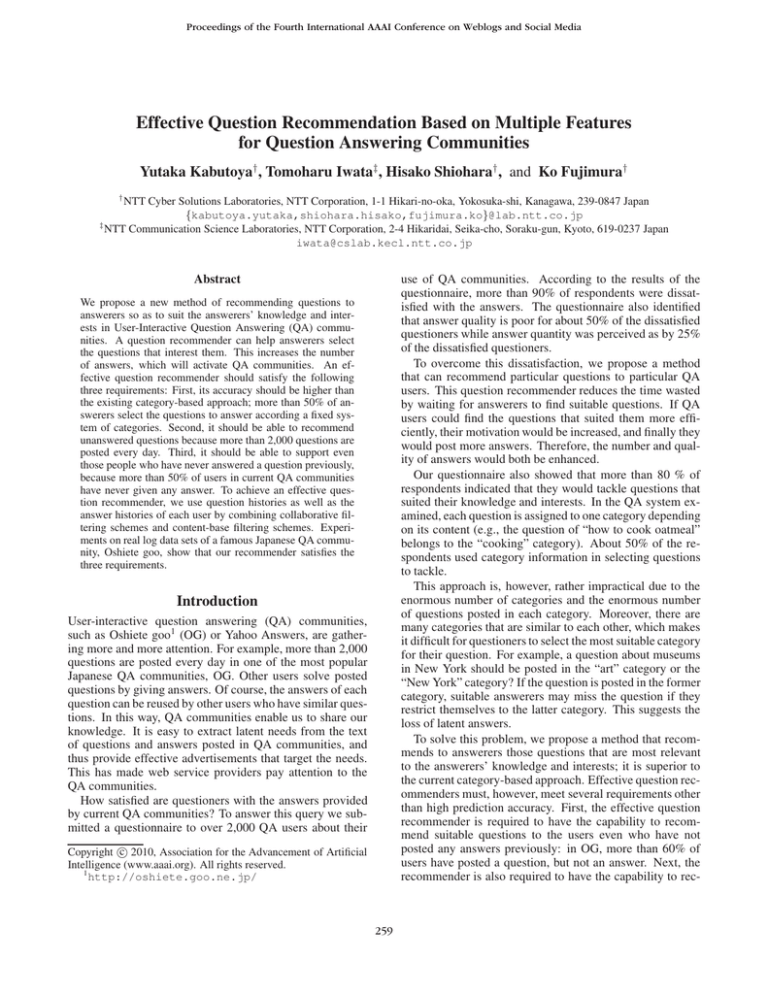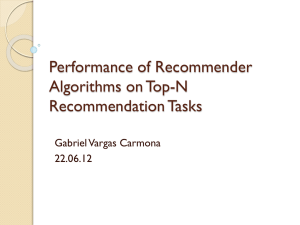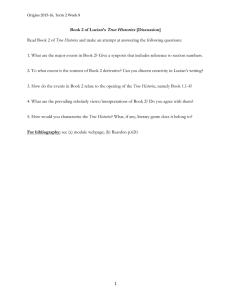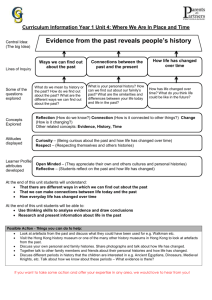
Proceedings of the Fourth International AAAI Conference on Weblogs and Social Media
Effective Question Recommendation Based on Multiple Features
for Question Answering Communities
Yutaka Kabutoya† , Tomoharu Iwata‡ , Hisako Shiohara† , and Ko Fujimura†
†
NTT Cyber Solutions Laboratories, NTT Corporation, 1-1 Hikari-no-oka, Yokosuka-shi, Kanagawa, 239-0847 Japan
{kabutoya.yutaka,shiohara.hisako,fujimura.ko}@lab.ntt.co.jp
‡
NTT Communication Science Laboratories, NTT Corporation, 2-4 Hikaridai, Seika-cho, Soraku-gun, Kyoto, 619-0237 Japan
iwata@cslab.kecl.ntt.co.jp
use of QA communities. According to the results of the
questionnaire, more than 90% of respondents were dissatisfied with the answers. The questionnaire also identified
that answer quality is poor for about 50% of the dissatisfied
questioners while answer quantity was perceived as by 25%
of the dissatisfied questioners.
To overcome this dissatisfaction, we propose a method
that can recommend particular questions to particular QA
users. This question recommender reduces the time wasted
by waiting for answerers to find suitable questions. If QA
users could find the questions that suited them more efficiently, their motivation would be increased, and finally they
would post more answers. Therefore, the number and quality of answers would both be enhanced.
Our questionnaire also showed that more than 80 % of
respondents indicated that they would tackle questions that
suited their knowledge and interests. In the QA system examined, each question is assigned to one category depending
on its content (e.g., the question of “how to cook oatmeal”
belongs to the “cooking” category). About 50% of the respondents used category information in selecting questions
to tackle.
This approach is, however, rather impractical due to the
enormous number of categories and the enormous number
of questions posted in each category. Moreover, there are
many categories that are similar to each other, which makes
it difficult for questioners to select the most suitable category
for their question. For example, a question about museums
in New York should be posted in the “art” category or the
“New York” category? If the question is posted in the former
category, suitable answerers may miss the question if they
restrict themselves to the latter category. This suggests the
loss of latent answers.
To solve this problem, we propose a method that recommends to answerers those questions that are most relevant
to the answerers’ knowledge and interests; it is superior to
the current category-based approach. Effective question recommenders must, however, meet several requirements other
than high prediction accuracy. First, the effective question
recommender is required to have the capability to recommend suitable questions to the users even who have not
posted any answers previously: in OG, more than 60% of
users have posted a question, but not an answer. Next, the
recommender is also required to have the capability to rec-
Abstract
We propose a new method of recommending questions to
answerers so as to suit the answerers’ knowledge and interests in User-Interactive Question Answering (QA) communities. A question recommender can help answerers select
the questions that interest them. This increases the number
of answers, which will activate QA communities. An effective question recommender should satisfy the following
three requirements: First, its accuracy should be higher than
the existing category-based approach; more than 50% of answerers select the questions to answer according a fixed system of categories. Second, it should be able to recommend
unanswered questions because more than 2,000 questions are
posted every day. Third, it should be able to support even
those people who have never answered a question previously,
because more than 50% of users in current QA communities
have never given any answer. To achieve an effective question recommender, we use question histories as well as the
answer histories of each user by combining collaborative filtering schemes and content-base filtering schemes. Experiments on real log data sets of a famous Japanese QA community, Oshiete goo, show that our recommender satisfies the
three requirements.
Introduction
User-interactive question answering (QA) communities,
such as Oshiete goo1 (OG) or Yahoo Answers, are gathering more and more attention. For example, more than 2,000
questions are posted every day in one of the most popular
Japanese QA communities, OG. Other users solve posted
questions by giving answers. Of course, the answers of each
question can be reused by other users who have similar questions. In this way, QA communities enable us to share our
knowledge. It is easy to extract latent needs from the text
of questions and answers posted in QA communities, and
thus provide effective advertisements that target the needs.
This has made web service providers pay attention to the
QA communities.
How satisfied are questioners with the answers provided
by current QA communities? To answer this query we submitted a questionnaire to over 2,000 QA users about their
c 2010, Association for the Advancement of Artificial
Copyright Intelligence (www.aaai.org). All rights reserved.
1
http://oshiete.goo.ne.jp/
259
Variable
Q
W
q
|W |
q = {qw }w=1
Uq
u
QA
u
QR
u
|W |
A
θA
u = {θuw }w=1
|W |
R
θR
u = {θuw }w=1
r
a
cq
f
F
Logistic Regression Model
Table 1: Notation
Description
Question set
Word set
Question
Keyword vector representation of q
User set answering q
User
Question set questioned by u
(u’s question histories)
Question set answered by u
(u’s answer histories)
Keyword vector representation of
u’s question histories
Keyword vector representation of
u’s answer histories
Whether a user answers a question
Whether a user posts a question
Category of q
Feature
Feature set
Jin et al. (Jin, Zhou, and Mobasher 2005) showed through
experiments that the accuracy of the logistic regression
model (maximum entropy model) is high for general recommendations. Hence, we consider the logistic regression
model to also be efficient in the question recommendation
problem. When the logistic regression model is applied to
our problem, the probability of user u answering question q
can be modeled as follows:
1
,
P (r = 1|u, q) =
1 + exp(− f ∈F λf Pf (r = 1|u, q) − λ0 )
(1)
where λ = {λf }f ∈F are unknown parameters.
We can obtain a global optimum solution for the unknown
parameters λ by maximizing the following logarithmic posteriori against training data sets X using optimization techniques such as the quasi-Newton methods.
log(P (λ|X )) ∝ log(P (λ)P (X|λ))
∝ −η||λ||2 +
+
u
u
ruq log(P (r = 1|u, q))
q
(1 − ruq )log(1 − P (r = 1|u, q)),
q
(2)
where we assume that a prior P (λ) follows a Gaussian distribution with hyperparameter η.
ommend even unanswered questions: in QA communities,
more than 2,000 questions a day are posted, and such newly
posted questions do not have any answers.
To achieve the question recommender that satisfies these
requirements, we propose a method by combining collaborative filtering schemes and content-base filtering schemes.
The collaborative filtering schemes are expected to yield
high recommendation accuracy regardless of the questions
content. On the other hand, the content-base filtering
schemes are expected to yield the capability to recommend
unanswered questions and to recommend to users who have
never answered a question previously.
Features
We employ six features as follows:
1. Probability to answer any questions in a category
Filtering questions against existing categories can be regarded as filtering questions by the probability of an answer existing in the category to which each question belongs.
PCategoryA (r = 1|u, q) = P (r = 1|u, cq ).
(3)
2. User-based collaborative filtering
This scheme is exploited by the recommender system
called “Grouplens” proposed by (Resnick et al. 1994).
This scheme has the advantage of yielding recommendations with high prediction accuracy regardless of question
content information (this explains of why we adopt this
scheme).
1 R
PUserCF (r = 1|u, q) =
cos(QR
u , Qu ), (4)
|Uq | Proposed Method
We propose here a question recommender system (QR) as
a function that supports answerers by finding questions that
are relevant to their knowledge and interests. QR provides
top-n questions ranked according to the relevancy between
the answerer and each unanswered question.
Effective QR satisfies the following three requirements:
u ∈Uq
1. Higher relevancy than the existing category function.
where cos means cosine similarity.
3. Item-based collaborative filtering
The recommendation scheme proposed by (Sarwar et al.
2001) offers reasonable computation cost and adequate
prediction accuracy.
1
cos(Uq , Uq ). (5)
PItemCF (r = 1|u, q) = R
|Qu | R
2. Activating users who have never answered any question:
whereas 253,072 users have given at least one answer,
327,669 users have never given anyanswer (but they have
posted questions) in OG as of June, 2009.
3. Solution of unanswered questions.
We now describe the variables used in this section; they
are described in Table 1. We exploit the tf-idf scheme to
represent a question as a keyword vector (The document set
for calculating idf values is Q).
q ∈Qu
This scheme also has the advantage of not utilizing question content information.
260
4. Content-base filtering using answer histories
This recommendation scheme was proposed by (Mooney
and Roy 2000). We exploit the term weight (tf-idf value)
of each word in the question as the content information.
This scheme has, unlike collaborative filtering schemes,
the ability to recommend (process) unanswered questions.
0.05
(6)
5. Content-base filtering using question histories
We consider that the knowledge and interests of a user
can be estimated from the term weight of each word in
the user’s questions. The advantage of using question histories is that, unlike existing recommendation schemes, it
makes it possible to recommend questions to users who
have not answered any question up to now.
PContentQ (r = 1|u, q) = cos(q, θA
u ).
0.04
0.03
0.02
0.01
0
1
2
3
4
5
6
7
8
9
10
n
(7)
Figure 1: Top-n accuracies
6. Probability of posting a question in a category
We also exploit the category information of a user’s question history as well as term weights.
PCategoryQ (r = 1|u, q) = P (a = 1|u, cq ).
OurMethod
ContentA
CategoryA
ContentQ
CategoryQ
ItemCF
UserCF
0.06
top-n accuracies
PContentA (r = 1|u, q) = cos(q, θ R
u ).
0.07
• OurMethod. The hyperparameter used to estimate weight
parameters in the logistic regression model is decided in
the following manner: First, we set 10 candidates for hyperparameter η {10−5 , 10−4 , . . . , 104 }. Next, we calculate top-n accuracy where the test data for each user is
taken to be the second-most recent question answered by
each user under the condition that hyperparameter η is set
to each candidate. Hyperparameter η is set to 10−2 since
this maximizes the top-n accuracy.
(8)
Experiments
A question that a user has actually answered can be regarded
as a question that is relevant to the user’s knowledge and
interests; this is confirmed by the questionnaire results reported in Subsection 2.3. We evaluate our method described
in Section 3 in terms of its ability to predict which question
a user will answer.
• CategoryA. The recommender system uses the probability
of each user being able to answer a question in each category. This method can be regarded as the existing category. Hence, comparing OurMethod against this baseline
is very important.
Datasets
Our data is based on a snapshot of a Japanese famous QA
community site, Oshiete goo, crawled in the period between
May 22nd, 2009 and May 31st, 2009. We exploited all of
the 24,272 questions in the snapshot above, all of the 53,354
answers, and all of the 5,559 answerers (users who gave least
two answers in the period or gave least one question and one
answer).
• UserCF, ItemCF, ContentA, ContentQ, and CategoryQ:
Each recommender system using a single feature.
Results
Top-n accuracy scores of each method are shown in Figure
1. The error bars of OurMethod line indicate the 99% confidence intervals of plots. First, we conducted a χ2 test to
determine if the difference between the top-n accuracy of
OurMethod and that of CategoryA is significant. We now
make null hypothesis H0 : the top-n accuracy scores of the
two methods are not different from each other (and converse hypothesis H1 : their top-n accuracy scores are different from each other). The test rejects the null hypothesis
with significance level of 0.01 for ∀n ∈ [1, 10].
Evaluation Metric
We determined the accuracy of predicting which question
each user will answer from the top-n accuracy. The procedure used to determine the top-n accuracy is as follows:
First, the most recent question of those answered by user u
is regarded as test data q̄u for user u. Questions older than
q̄u are regarded as training data for u. Next, relevancy of
u against q̄u and each of the questions which u did not answer is calculated using recommendation methods. When
q̄u is included in the n most relevant questions to u, the correct questions are considered to have been recommended to
u. The top-n accuracy is given by the fraction of users to
which correct questions are recommended.
Consideration
The top-n accuracy of our method is higher than that of
probability of answering in each category at the significance
level of 0.01; therefore, OurMethod can pair answerers with
more suitable questions than is possible withthe existing category approach.
The weights of schemes using answer histories are higher
than those of schemes using question histories. The number
Methods Compared
The baselines are recommenders that use single features. We
now describe our method and the baselines:
261
0.03
0.06
OurMethod
ContentA
CategoryA
ContentQ
CategoryQ
ItemCF
UserCF
0.02
0.05
top-n accuracies
top-n accuracies
0.025
OurMethod
ContentA
CategoryA
ContentQ
CategoryQ
ItemCF
UserCF
0.015
0.01
0.005
0.04
0.03
0.02
0.01
0
0
1
2
3
4
5
6
7
8
9
10
n
1
2
3
4
5
6
7
8
9
10
n
Figure 2: Top-n accuracy scores for users who have never
answered
Figure 3: Top-3 accuracy scores versus number of questions
answered
of a user’s positive examples, used to estimate weight parameters, is equal to the number of questions that the user
answered. Hence, the mote items the user’s answer history
contains, the more influence the user has on the estimation
of weight parameters. This explains why answer histories
are more efficient than question histories in recommending
suitable questions to users who have answered many questions.
The lower weights of schemes that use question histories
seems to suggest a fault with our method; suitable questions cannot be recommended to users who have only entered questions. That OurMethod can recommend questions
to these users is validated in the analysis reported in Section
5.
users whose test data is not unanswered by other users are
shown in Figure 2. The result shows that OurMethod is efficient to recommend even unanswered questions. The recommenders that use content information in questions, such as
CategoryA or ContentA, is trivially efficient against unanswered questions. On the contrary, recommenders based
on collaborative filtering are not efficient since unanswered
questions provide no useful information (this is called the
“Cold-Start” problem).
References
Jin, X.; Zhou, Y.; and Mobasher, B. 2005. A maximum
entropy web recommendation system: combining collaborative and content features. In KDD ’05: Proceedings of the
eleventh ACM SIGKDD international conference on Knowledge discovery in data mining, 612–617. ACM.
Mooney, R., and Roy, L. 2000. Content-based book recommending using learning for text categorization. In DL
’00: Proceedings of the fifth ACM conference on Digital libraries, 195–204. ACM.
Resnick, P.; Iacovou, N.; Suchak, M.; Bergstrom, P.; and
Riedl, J. 1994. Grouplens: an open architecture for collaborative filtering of netnews. In CSCW ’94: Proceedings of the
1994 ACM conference on Computer supported cooperative
work, 175–186. ACM.
Sarwar, B.; Karypis, G.; Konstan, J.; and Reidl, J. 2001.
Item-based collaborative filtering recommendation algorithms. In WWW ’01: Proceedings of the 10th international
conference on World Wide Web, 285–295. ACM.
Analysis
We consider that question recommender systems have several requirements other than high prediction accuracy. We
now describe the requirements as follows:
• Questions should be recommended to users even if they
have never answered a question before.
• Unanswered questions should be recommended.
We analyzed OurMethod in terms of these requirements
above in this section.
Accuracy Scores for Questioners
First, we validate whether OurMethod is efficient regardless of the frequency of answering. Top-n accuracy scores
for 829 users who have never answered but questioned are
shown in Figure 2. The experimental result shows that our
method is not efficient for such questioners. This weakness
is caused by paucity of useful information contained within
question histories.
Accuracy Scores for Unanswered Questions
Next, we confirmed whether OurMethod can efficiently handle unanswered questions. Top-n accuracy scores for 719
262




